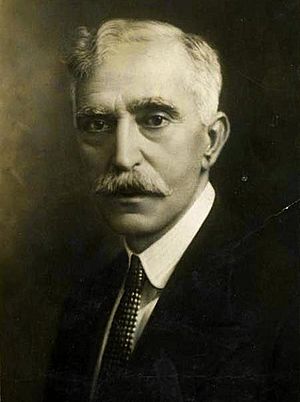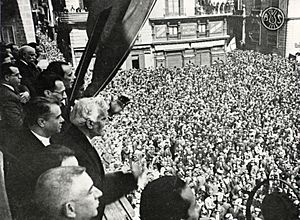Francesc Macià facts for kids
Quick facts for kids
Francesc Macià i Llussà
|
|
|---|---|
 |
|
| 122nd president of the Government of Catalonia | |
| In office 14 December 1932 – 25 December 1933 |
|
| President | Niceto Alcalá-Zamora |
| Preceded by | Josep de Vilamala |
| Succeeded by | Lluís Companys |
| 3rd acting president of the Catalan Republic | |
| In office 14 April 1931 – 17 April 1931 |
|
| Preceded by | Baldomer Lostau in 1873 |
| Succeeded by | Lluís Companys in 1934 |
| Acting President of the Generalitat de Catalunya | |
| In office 17 April 1931 – 14 December 1932 |
|
| Preceded by | Himself as Acting President of the Catalan Republic |
| Succeeded by | Himself as President of the Generalitat de Catalunya |
| Personal details | |
| Born | 21 September 1859 Vilanova i la Geltrú, Catalonia, Kingdom of Spain |
| Died | 25 December 1933 (aged 74) Barcelona, Catalonia, Spanish Republic |
| Political party | Estat Català Republican Left of Catalonia |
| Spouse | Eugènia Lamarca i de Mier |
| Signature | |
Francesc Macià i Llussà (born September 21, 1859 – died December 25, 1933) was an important Spanish politician from Catalonia. He became the 122nd president of the Government of Catalonia. Before that, he was an officer in the Spanish Army.
He started his political journey wanting to improve Spain. Later, he became a strong supporter of an independent Catalan Republic. He was the first president of the restored Government of Catalonia. He helped Catalonia gain its own self-government for the first time in modern history.
Contents
Who Was Francesc Macià?
Early Life and Military Career
Francesc Macià i Llussà was born in Vilanova i la Geltrú, a town in Catalonia, Spain. When he was 16, his father passed away. After this, he joined the Military Academy of Guadalajara. He became an engineer in the Spanish Army. He specialized in building bridges, railways, and telegraph systems.
He worked in different cities like Barcelona, Madrid, and Seville. He started as a telegrapher and rose to the rank of captain. He wanted the Spanish army to become more modern. Eventually, he became a lieutenant-colonel. In 1887, he moved to Lleida. There, he met Eugènia Lamarca, who became his wife. They had three children together: Joan, Eugènia, and Maria.
Standing Up for Catalonia
In 1905, some Spanish army officers attacked the offices of two Catalan newspapers. This was because of a joke in a satirical magazine called ¡Cu-Cut!. The Spanish government then created a law to punish crimes against the country and the army. This made many political groups in Catalonia join together. They formed a group called Solidaritat Catalana, which means 'Catalan Solidarity'.
Macià publicly spoke out against the army's actions. Because of this, he was moved to Santoña, a town far away in Cantabria.
Becoming a Politician
In 1907, Macià ran for election as part of Catalan Solidarity. He won a seat in the Spanish Congress. He was re-elected many times until 1923. At first, he wanted to improve Spain as a whole. But over time, he started to support Catalonia having more self-rule. Eventually, he became a strong supporter of Catalonia's independence.
In 1919, he started the Nationalist Democratic Federation. This group wanted Spain to be a federal country. In this setup, Catalonia would have a lot of self-government. In 1922, Macià founded his own party, Estat Català, which means 'Catalan State'. This party openly supported independence for Catalonia.
The Prats de Molló Plot
In September 1923, a military leader named Miguel Primo de Rivera took control of Spain. Macià had to leave Spain and went to Perpignan, France. In 1926, he tried to start an uprising against Primo de Rivera's rule. This plan was called the plot of Prats de Molló.
The goal was to achieve independence for Catalonia. Macià planned this from Prats de Molló, a town in southern France. He hired between 50 and 100 Italian soldiers to help. However, the French police stopped the plan before it could begin. Macià was arrested and spent two months in jail.
Even though the plan failed, Macià and his goal became very popular in Catalonia. He left France in 1927 and went to Brussels, Belgium. There, he became even more well-known. He returned to Spain in 1930 and again in 1931.
The Catalan Republic and Generalitat
Forming a New Party
In March 1931, Macià's party, Estat Català, joined with two other Catalan parties. They formed a new, bigger party called Republican Left of Catalonia (ERC). Francesc Macià became the main leader of this new party.
Proclaiming the Catalan Republic

On April 14, 1931, something big happened in Spain. Local elections had just taken place, and the king, Alfonso XIII, had to leave the country. A few hours before the Second Spanish Republic was declared in Madrid, Macià made an important announcement.
From the balcony of the Palau de la Generalitat in Barcelona, he declared the "Catalan Republic." He hoped that other parts of Spain would also become republics and then form an "Iberian Confederation" together. Macià was named the acting president of Catalonia.
Agreement with Spain
Three days later, the new Spanish Republic sent three ministers to Barcelona. They met with Macià and the Catalan government to talk. Macià reached an agreement with them. The Catalan Republic was renamed the Generalitat of Catalonia. This meant it became an autonomous (self-governing) region within the Spanish Republic.
Macià continued as the acting President of the Generalitat. The main job of this new government was to write the Statute of Autonomy. This document outlined how Catalonia would govern itself. The Spanish Congress approved it in September 1932.
President of the Generalitat
In November 1932, the first Catalan parliamentary election took place. Macià's party, ERC, won by a lot. After this victory, he was officially named President of the Generalitat of Catalonia. He held this important position until he passed away in December 1933.
Passing Away

Francesc Macià died on December 25, 1933, in Barcelona. He passed away due to appendicitis. His funeral was a huge event, with many people showing their sadness. His remains are buried in the Plaça de la Fe at the Montjuïc Cemetery in Barcelona.
Images for kids
See also
 In Spanish: Francesc Macià para niños
In Spanish: Francesc Macià para niños
- Plaça de Francesc Macià, Barcelona


